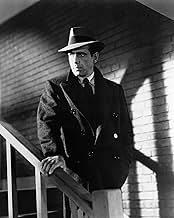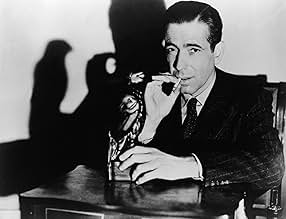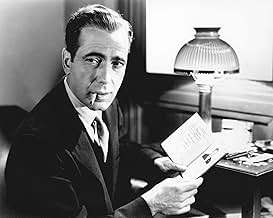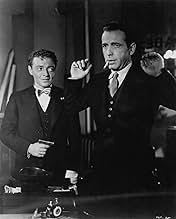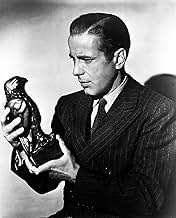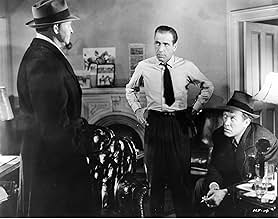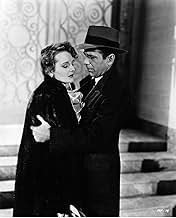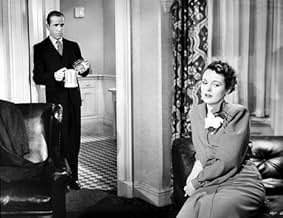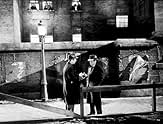Ein Privatdetektiv übernimmt einen Fall, der ihn mit drei exzentrischen Ganoven, einer hinreißenden Lügnerin und ihrer Suche nach einer unbezahlbaren Statuette zusammenbringt.Ein Privatdetektiv übernimmt einen Fall, der ihn mit drei exzentrischen Ganoven, einer hinreißenden Lügnerin und ihrer Suche nach einer unbezahlbaren Statuette zusammenbringt.Ein Privatdetektiv übernimmt einen Fall, der ihn mit drei exzentrischen Ganoven, einer hinreißenden Lügnerin und ihrer Suche nach einer unbezahlbaren Statuette zusammenbringt.
- Regie
- Drehbuch
- Hauptbesetzung
- Für 3 Oscars nominiert
- 8 Gewinne & 4 Nominierungen insgesamt
Charles Drake
- Reporter
- (Nicht genannt)
Chester Gan
- Bit Part
- (Nicht genannt)
Creighton Hale
- Stenographer
- (Nicht genannt)
Robert Homans
- Policeman
- (Nicht genannt)
William Hopper
- Reporter
- (Nicht genannt)
Empfohlene Bewertungen
Considered by many film historians as the very first noir film, "The Maltese Falcon" is cinematically important also for making Humphrey Bogart into a Hollywood star, and for being the debut of John Huston as film Director.
The film's story is complex and convoluted, typical of detective films of that era, and involves a valuable statuette. The plot stalls and meanders throughout most of the film, as we encounter an assortment of strange characters and side issues. But this is not a plot-driven film. It is character-driven.
And the main character, of course, is PI Sam Spade (Bogart). He's not a particularly nice guy. He comes across as overconfident and egotistic. He smirks a lot. But he's tough as nails. And he knows how to nail the bad guys. A big part of the film is Spade's relationship to femme fatale Brigid (Mary Astor). They engage each other in a battle of wits. And there's more than a hint of romantic involvement between the two. But Brigid is the one who propels Spade into the deceiving and double-crossing world of bad guys who yearn with greed for the priceless Maltese Falcon.
Enter Kasper Gutman, that thoroughly rotund and intimidating (in a gentlemanly sort of way) king of greed, portrayed with verve and panache by the inimitable Sydney Greenstreet. Gutman, AKA the "Fat Man", is nothing if not erudite and self-assured. In one scene, Sam Spade makes a bold offer. Gutman responds articulately: "That's an attitude sir that calls for the most delicate judgment on both sides, because as you know sir, in the heat of action, men are likely to forget where their best interests lie ...".
And Peter Lorre is a hoot as Gutman's mischievous elf, Joel Cairo, who tries, without success, to threaten Sam Spade, but only succeeds at getting on Sam's nerves.
The film's high contrast B&W lighting renders an effective noir look and feel, one that would be copied in films for years to come. Acting varies from very good to overly melodramatic. The script is very talky. For the most part, the film is just a series of conversations that take place in interior sets.
Stylistic and cinematically innovative, "The Maltese Falcon" has endured as a film classic. I suspect the main reason for its continued popularity is the continued popularity of Bogart. But I personally prefer the performance of Sydney Greenstreet, the enticing fat man. Yet, together they would reappear in later films, one of which would follow, in 1942, as the classic of all classics.
The film's story is complex and convoluted, typical of detective films of that era, and involves a valuable statuette. The plot stalls and meanders throughout most of the film, as we encounter an assortment of strange characters and side issues. But this is not a plot-driven film. It is character-driven.
And the main character, of course, is PI Sam Spade (Bogart). He's not a particularly nice guy. He comes across as overconfident and egotistic. He smirks a lot. But he's tough as nails. And he knows how to nail the bad guys. A big part of the film is Spade's relationship to femme fatale Brigid (Mary Astor). They engage each other in a battle of wits. And there's more than a hint of romantic involvement between the two. But Brigid is the one who propels Spade into the deceiving and double-crossing world of bad guys who yearn with greed for the priceless Maltese Falcon.
Enter Kasper Gutman, that thoroughly rotund and intimidating (in a gentlemanly sort of way) king of greed, portrayed with verve and panache by the inimitable Sydney Greenstreet. Gutman, AKA the "Fat Man", is nothing if not erudite and self-assured. In one scene, Sam Spade makes a bold offer. Gutman responds articulately: "That's an attitude sir that calls for the most delicate judgment on both sides, because as you know sir, in the heat of action, men are likely to forget where their best interests lie ...".
And Peter Lorre is a hoot as Gutman's mischievous elf, Joel Cairo, who tries, without success, to threaten Sam Spade, but only succeeds at getting on Sam's nerves.
The film's high contrast B&W lighting renders an effective noir look and feel, one that would be copied in films for years to come. Acting varies from very good to overly melodramatic. The script is very talky. For the most part, the film is just a series of conversations that take place in interior sets.
Stylistic and cinematically innovative, "The Maltese Falcon" has endured as a film classic. I suspect the main reason for its continued popularity is the continued popularity of Bogart. But I personally prefer the performance of Sydney Greenstreet, the enticing fat man. Yet, together they would reappear in later films, one of which would follow, in 1942, as the classic of all classics.
Sam Spade and Miles Archer are detectives, the private type who you can give directives, after meeting with a dame, there then begins a deadly game, with a group who seem to have, their own perspectives; although they all have as their goal a missing falcon, and soon there are some folks, who find their souls gone, as beneath the dark veneer, there are those quite insincere, as you'll find after a number of liaisons; as the story ratchets up the threads combine, and at the centre of the plot's a large waistline, that speaks with eloquence and intent, as deep within, passions ferment, in a film that is a classic of its time.
Great cast, great story, great film - but isn't Sydney Greenstreet outstanding!
Great cast, great story, great film - but isn't Sydney Greenstreet outstanding!
If not, it's pretty damn close. My husband and I are different than most because instead of just looking for movies we tend to find actors we love and then watch all of their movies. We're fans of the star first and then the movie second. Humphrey Bogart had it all. He was authentic, compelling, and could convey so many emotions with just a twinkle or a tinge of doubt, or suspicion, or fear, or lust, or greed, whatever it was he had to convey, he did it with full conviction. If there's a better movie star that ever lived, I can't name them. There may be actors with more range, but not better movie stars. I think actors can be great even if they don't transform as Day-Lewis does. Don't get me wrong, Day-Lewis is a genius, but an actor who is completely authentic and compelling (something going on underneath) is just as interesting to watch as an actor who transforms themselves.
Humphrey Bogart died nearly fifty years ago, but polls still put him at the top of all-time Hollywood stars. What turns a man into a legend? The man himself wasn't much: a slight build, not too tall, no Stallone muscles to swell his suit. What he had in classic films like `The Maltese Falcon' was a voice that cut through a script like a knife. `The Maltese Falcon,' directed by John Huston in 1941, reprised Dashiell Hammett's thriller. (It had been filmed before.) Hammett practically invented the tough guy so deep in cynicism nobody could hope to put anything past him. The novel, thick with plot, wasn't easy for director John Huston to untangle. Few people who cherish this film can summarize its story in a sentence or two. I'll try. San Francisco private eye Sam Spade (Bogart) is pulled into the search for a fabulously valuable statue by a woman who seeks his help. First, his partner is killed, then Spade pushes through her lies to uncover connections to an effete foreigner (Peter Lorre) and a mysterious kingpin (Sydney Greenstreet). The story unfolds like a crumpled paper. But the whodunit becomes less important than how we respond to the strong screen presence of Bogart and his co-stars. That's what makes `The Maltese Falcon' a classic. We see more and appreciate more each time we watch it. The art of Huston and Bogart doesn't come across until a second or third viewing. Huston invented what the French called film noir, in honor of Hollywood films (often `B' movies, cheap to make, second movies in double features) that took no-name stars into city streets to pit tough guys, often with a vulnerable streak, against dangerous dames. Audiences knew that when the tough guy said, `I'm wise to you, babe,' he'd be dead within a reel or two. Bogart was luckier than most noir heroes, but it cost. Struggling to maintain his own independence against the claims of love or his own penchant towards dishonesty the Bogart hero can do little better than surrender, with a rueful shrug, to the irony his survival depends on. The climax of `The Maltese Falcon' ranks with the last scene of `Casablanca,' another Bogart vehicle, in showing how the tough guy has to put himself back together after his emotions almost get the better of him. That assertion of strength, bowed but not broken, defines the enduring quality of Bogart on screen. For Huston, telling this story posed a different problem. Telling it straight wasn't possible too many twists. Huston chose to focus on characters. One way to appreciate Huston's choices is to LISTEN to the movie. Hear the voices. Notice how in long sequences narrating back story, Huston relies on the exotic accents of his characters to keep us interested. Could we endure the scene in which Greenstreet explains the history of the Maltese falcon unless his clipped, somewhat prissy English accent held our attention? Also, we watch Bogart slip into drug-induced sleep while Greenstreet drones on. Has any director thought of a better way to keep us interested during a long narrative interlude? And is there a bit of wit in our watching Bogart nod off during a scene which, if told straight, would make US doze? All of this leads to the ending, minutes of screen time in which more goes on, gesture by gesture, than a million words could summarize. He loves her, maybe, but he won't be a sucker. The cops come in, and the emotional color shifts to gray, the color of film noir heroes like Bogart. Bars on the elevator door as Brigid descends in police custody foreshadow her fate in the last image of Huston's film. But after the film, we're left with Spade, whom we like and loathe, a man whose sense of justice squares, just this once, with our own, maybe. Black and white morality prevails in a black and white movie, but Sam Spade remains gray and so does our response to this film classic.
With a fine combination of cast, characters, story, and atmosphere, this classic is one of the most entertaining films of its kind, enjoyable even after several viewings. It gets you right into the action and introduces you to a list of interesting personalities, who mesh together nicely and who are also matched well with the cast members. Beyond that, it's also effective as a character study involving greed, trust and distrust, and conflicting ethics.
Sam Spade is an ideal role for Bogart, giving him plenty to work with and some very good dialogue as well. Peter Lorre and Sydney Greenstreet are very entertaining, providing suitable foils for Bogart, and they really take the film up a notch. The rest of the cast also works well (worth mentioning is Elisha Cook, Jr., whose character doesn't do a lot, but who provides Bogart with some very amusing moments at his expense). The story is nicely adapted from the novel, and each scene is constructed well, with everything moving along nicely from start to finish.
If you are a fan of either film noir or mysteries, make this a must-see. There are very few films that work as well as "The Maltese Falcon".
Sam Spade is an ideal role for Bogart, giving him plenty to work with and some very good dialogue as well. Peter Lorre and Sydney Greenstreet are very entertaining, providing suitable foils for Bogart, and they really take the film up a notch. The rest of the cast also works well (worth mentioning is Elisha Cook, Jr., whose character doesn't do a lot, but who provides Bogart with some very amusing moments at his expense). The story is nicely adapted from the novel, and each scene is constructed well, with everything moving along nicely from start to finish.
If you are a fan of either film noir or mysteries, make this a must-see. There are very few films that work as well as "The Maltese Falcon".
Wusstest du schon
- WissenswertesThree of the falcon statuettes made for the production still exist and are conservatively valued at over $1 million each. This makes them some of the most valuable film props ever made; indeed, each is now worth more than three times what the film cost to make.
- PatzerSpade doesn't wear rings or a watch throughout the movie except for one scene. At one point he walks into his office wearing a wedding band on his left hand, another large ring on his right hand and an expensive looking wristwatch. He sits down to have a quick chat with his secretary where the rings and watch are in plain view. He then walks through a doorway into his inner office and the rings and watch are gone.
- Zitate
Joel Cairo: You always have a very smooth explanation ready.
Sam Spade: What do you want me to do, learn to stutter?
- Alternative VersionenAlso available in a computer colorized version.
- VerbindungenEdited into Geschichten aus der Gruft: You, Murderer (1995)
Top-Auswahl
Melde dich zum Bewerten an und greife auf die Watchlist für personalisierte Empfehlungen zu.
Details
- Erscheinungsdatum
- Herkunftsland
- Sprache
- Auch bekannt als
- Der Malteser Falke
- Drehorte
- Bush Street, San Francisco, Kalifornien, USA(death of Miles Archer)
- Produktionsfirma
- Weitere beteiligte Unternehmen bei IMDbPro anzeigen
Box Office
- Budget
- 375.000 $ (geschätzt)
- Bruttoertrag in den USA und Kanada
- 18.180 $
- Weltweiter Bruttoertrag
- 41.740 $
- Laufzeit1 Stunde 40 Minuten
- Farbe
- Seitenverhältnis
- 1.37 : 1
Zu dieser Seite beitragen
Bearbeitung vorschlagen oder fehlenden Inhalt hinzufügen




